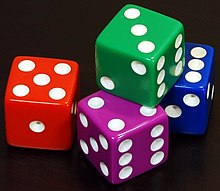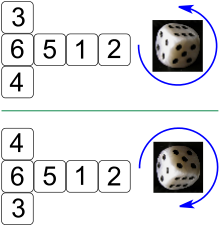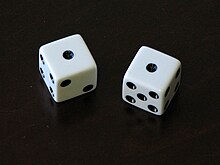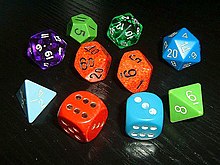|
Dice
 A die (sg.: die or dice; pl.: dice)[1] is a small, throwable object with marked sides that can rest in multiple positions. Dice are used for generating random values, commonly as part of tabletop games, including dice games, board games, role-playing games, and games of chance. A traditional die is a cube with each of its six faces marked with a different number of dots (pips) from one to six. When thrown or rolled, the die comes to rest showing a random integer from one to six on its upper surface, with each value being equally likely. Dice may also have polyhedral or irregular shapes, may have faces marked with numerals or symbols instead of pips and may have their numbers carved out from the material of the dice instead of marked on it. Loaded dice are specifically designed or modified to favor some results over others for cheating or entertainment. HistoryDice have been used since before recorded history, and their origin is uncertain. It is hypothesized that dice developed from the practice of fortune-telling with the talus of hoofed animals, colloquially known as knucklebones.[2] The Ancient Egyptian game of senet (played before 3000 BCE and up to the 2nd century CE) was played with flat two-sided throwsticks which indicated the number of squares a player could move, and thus functioned as a form of dice.[3] Perhaps the oldest known dice were excavated as part of a backgammon-like game set at the Burnt City, an archeological site in south-eastern Iran, estimated to be from between 2800 and 2500 BCE.[4][5] Bone dice from Skara Brae, Scotland have been dated to 3100–2400 BCE.[6] Excavations from graves at Mohenjo-daro, an Indus Valley civilization settlement, unearthed terracotta dice dating to 2500–1900 BCE,[7] including at least one die whose opposite sides all add up to seven, as in modern dice.[8] Games involving dice are mentioned in the ancient Indian Rigveda,[9] Atharvaveda, Mahabharata and the Buddhist games list.[10] There are several biblical references to "casting lots" (Hebrew: יפילו גורל yappîlū ḡōrāl), as in Psalm 22, indicating that dicing (or a related activity) was commonplace when the psalm was composed. Knucklebones was a game of skill played in ancient Greece; a derivative form had the four sides of bones receive different values like modern dice.[11] Although gambling was illegal, many Romans were passionate gamblers who enjoyed dicing, which was known as aleam ludere ("to play at dice"). There were two sizes of Roman dice. Tali were large dice inscribed with one, three, four, and six on four sides. Tesserae were smaller dice with sides numbered from one to six.[12] Twenty-sided dice date back to the 2nd century CE[13] and from Ptolemaic Egypt as early as the 2nd century BCE.[14] Dominoes and playing cards originated in China as developments from dice.[15] The transition from dice to playing cards occurred in China around the Tang dynasty (618–907 CE), and coincides with the technological transition from rolls of manuscripts to block printed books.[16] In Japan, dice were used to play a popular game called sugoroku. There are two types of sugoroku. Ban-sugoroku is similar to backgammon and dates to the Heian period (794–1185 CE), while e-sugoroku is a racing game.[17]
UseDice are thrown onto a surface either from the hand or from a container designed for this (such as a cup, tray, or tower). The face (or corner, in cases such as tetrahedral dice, or edge, for odd-numbered long dice) of the die that is uppermost when it comes to rest provides the value of the throw. The result of a die roll is determined by the way it is thrown, according to the laws of classical mechanics (although luck is often credited for the results of a roll). A die roll is made random by uncertainty in minor factors such as tiny movements in the thrower's hand; they are thus a crude form of hardware random number generator. One typical contemporary dice game is craps, where two dice are thrown simultaneously and wagers are made on the total value of the two dice. Dice are frequently used to introduce randomness into board games, where they are often used to decide the distance through which a piece will move along the board (as in backgammon and Monopoly). Thrown or simulated dice are sometimes used to generate specific probability distributions, which are fundamental to probability theory. For example, rolling a single six-sided die yields a uniform distribution, where each number from 1 to 6 has an equal chance of appearing. However, when rolling two dice and summing the results, the probability distribution shifts, as some sums (like 7) become more likely than others (like 2 or 12). These distributions can model real-world scenarios or mathematical constructs, making dice a practical tool for teaching and exploring concepts in probability theory. ConstructionArrangement Common dice are small cubes, most often 1.6 cm (0.63 in) across, whose faces are numbered from one to six, usually by patterns of round dots called pips. (While the use of Arabic numerals is occasionally seen, such dice are less common.) Opposite sides of a modern die traditionally add up to seven, requiring the 1, 2, and 3 faces to share a vertex.[18] The faces of a die may be placed clockwise or counterclockwise about this vertex. If the 1, 2, and 3 faces run counterclockwise, the die is called "right-handed". If those faces run clockwise, the die is called "left-handed". Western dice are normally right-handed, and Chinese dice are normally left-handed.[19] The pips on standard six-sided dice are arranged in specific patterns as shown. Asian style dice bear similar patterns to Western ones, but the pips are closer to the center of the face; in addition, the pips are differently sized on Asian style dice, and the pips are colored red on the 1 and 4 sides. Red fours may be of Indian origin.[19][20]
Manufacturing In general, dice are classified as either precision or non-precision. Precision dice (also known as perfect or gambling house dice) are used in casinos, while non-precision dice (also known as drugstore or candystore dice) are sold with social and board games. These types are easily distinguished with visual and tactile differences; precision dice generally are larger, translucent, and have flush markings, sharp corners and edges, while non-precision dice generally are smaller, opaque, and have recessed markings, rounded corners and edges.[21]: 23–24 Non-precision dice are manufactured via the plastic injection molding process, often made of polymethyl methacrylate (PMMA). The pips or numbers on the die are a part of the mold. Different pigments can be added to the dice to make them opaque or transparent, or multiple pigments may be added to make the dice speckled or marbled.[22] The coloring for numbering is achieved by submerging the die entirely in paint, which is allowed to dry. The die is then polished via a tumble finishing process similar to rock polishing. The abrasive agent scrapes off all of the paint except for the indents of the numbering. A finer abrasive is then used to polish the die. This process also produces the smoother, rounded edges on the dice.  Precision dice are generally made from bars of extruded cellulose acetate, sawed to the proper length to ensure that each face is as square as practical, generally with edges 3⁄4 ± 1⁄5000 in (19.0500 ± 0.0051 mm) in length, with pips drilled 17 ± 4 mils (0.43 ± 0.10 mm) deep and filled with opaque paint or epoxy which matches the density of cellulose, ensuring the dice remain balanced.[21]: 23 [23] The dice are buffed and polished to a gloss or sand finish after the pips are set, and the edges usually are left sharp, also called square or razor edge, although beveled or rounded edges, if performed evenly and consistently for each edge, are acceptable.[21]: 240 Precision casino dice are transparent or translucent. This makes it difficult to incorporate internal weights which could bias the roll.[21]: 213–214, 253 To discourage cheating by dice substitution, each die carries a serial number and the casino's logo or name.[21]: 23–24 Local regulations and the intended game may affect the allowable dimensions and tolerances; for example, New Jersey specifies the maximum size of a die is 0.775 in (19.7 mm) on a side, except for the dice used in pai gow, which range from 0.637–0.643 in (16.2–16.3 mm) on a side.[24]: 13:69E-1.15  Precision backgammon dice are made the same way and also feature pips flush with the surface of each face; they tend to be slightly smaller and have rounded corners and edges, to allow better movement inside the dice cup and stop forceful rolls from damaging the playing surface.[25] Etymology and termsThe word die comes from Old French dé; from Latin datum "something which is given or played".[26] While the terms ace, deuce, trey, cater, cinque and sice are generally obsolete, with the names of the numbers preferred, they are still used by some professional gamblers to designate different sides of the dice. Ace is from the Latin as, meaning "a unit";[27] the others are 2 to 6 in Old French.[28] When rolling two dice, certain combinations have slang names. The term snake eyes is a roll of one pip on each die. The Online Etymology Dictionary traces use of the term as far back as 1919.[29] The US term boxcars, also known as midnight, is a roll of six pips on each die. The pair of six pips resembles a pair of boxcars on a freight train. Many rolls have names in the game of craps. Unicode representation
Using Unicode characters, the faces can be shown in text using the range U+2680 to U+2685 or using decimal Loaded diceA loaded, weighted, cheat, or crooked die is one that has been tampered with so that it will land with a specific side facing upwards more often or less often than a fair die would. There are several methods for making loaded dice, including rounded faces, off-square faces, and weights. Casinos and gambling halls frequently use transparent cellulose acetate dice, as tampering is easier to detect than with opaque dice.[31] VariantsPolyhedral dice Various shapes such as two-sided or four-sided dice are documented in archaeological findings; for example, from Ancient Egypt and the Middle East. While the cubical six-sided die became the most common type in many parts of the world, other shapes were always known, like 20-sided dice in Ptolemaic and Roman times. The modern tradition of using sets of polyhedral dice started around the end of the 1960s when non-cubical dice became popular among players of wargames,[32] and since have been employed extensively in role-playing games and trading card games. Dice using both the numerals 6 and 9, which are reciprocally symmetric through rotation, typically distinguish them with a dot or underline. Common variationsDice are often sold in sets, matching in color, of six different shapes. Five of the dice are shaped like the Platonic solids, whose faces are regular polygons. Aside from the cube, the other four Platonic solids have 4, 8, 12, and 20 faces, allowing for those number ranges to be generated. The only other common non-cubical die is the 10-sided die, a pentagonal trapezohedron die, whose faces are ten kites, each with two different edge lengths, three different angles, and two different kinds of vertices. Such sets frequently include a second 10-sided die either of contrasting color or numbered by tens, allowing the pair of 10-sided dice to be combined to generate numbers between 1 and 100. Using these dice in various ways, games can closely approximate a variety of probability distributions. For instance, 10-sided dice can be rolled in pairs to produce a uniform distribution of random percentages, and summing the values of multiple dice will produce approximations to normal distributions.[33] Unlike other common dice, a four-sided (tetrahedral) die does not have a side that faces upward when it is at rest on a surface, so it must be read in a different way. On some four-sided dice, each face features multiple numbers, with the same number printed near each vertex on all sides. In this case, the number around the vertex pointing up is used. Alternatively, the numbers on a tetrahedral die can be placed at the middle of the edges, in which case the numbers around the base are used. Normally, the faces on a die will be placed so opposite faces will add up to one more than the number of faces. (This is not possible with 4-sided dice and dice with an odd number of faces.) Some dice, such as those with 10 sides, are usually numbered sequentially beginning with 0, in which case the opposite faces will add to one less than the number of faces. Some twenty-sided dice have a different arrangement used for the purpose of keeping track of an integer that counts down, such as health points. These spindown dice are arranged such that adjacent integers appear on adjacent faces, allowing the user to easily find the next lower number. They are commonly used with collectible card games.[34]
Rarer variations "Uniform fair dice" are dice where all faces have an equal probability of outcome due to the symmetry of the die as it is face-transitive. In addition to the Platonic solids, these theoretically include:
Two other types of polyhedra are technically not face-transitive but are still fair dice due to symmetry:
Long dice and teetotums can, in principle, be made with any number of faces, including odd numbers.[35] Long dice are based on the infinite set of prisms. All the rectangular faces are mutually face-transitive, so they are equally probable. The two ends of the prism may be rounded or capped with a pyramid, designed so that the die cannot rest on those faces. 4-sided long dice are easier to roll than tetrahedra and are used in the traditional board games dayakattai and daldøs.
Non-numeric dice The faces of most dice are labelled using sequences of whole numbers, usually starting at one, expressed with either pips or digits. However, there are some applications that require results other than numbers. Examples include letters for Boggle, directions for Warhammer Fantasy Battle, Fudge dice, playing card symbols for poker dice, and instructions for sexual acts using sex dice. Alternatively-numbered diceDice may have numbers that do not form a counting sequence starting at one. One variation on the standard die is known as the "average" die.[38][39] These are six-sided dice with sides numbered Spherical dice A die can be constructed in the shape of a sphere, with the addition of an internal cavity in the shape of the dual polyhedron of the desired die shape and an internal weight. The weight will settle in one of the points of the internal cavity, causing it to settle with one of the numbers uppermost. For instance, a sphere with an octahedral cavity and a small internal weight will settle with one of the 6 points of the cavity held downwards by the weight. Applications Many board games use dice to randomize how far pieces move or to settle conflicts. Typically, this has meant that rolling higher numbers is better. Some games, such as Axis & Allies, have inverted this system by making the lower values more potent. In the modern age,[when?] a few games and game designers have approached dice in a different way by making each side of the die similarly valuable. In Castles of Burgundy, players spend their dice to take actions based on the die's value. In this game, a six is not better than a one, or vice versa. In Quarriors (and its descendant, Dice Masters), different sides of the dice can offer completely different abilities. Several sides often give resources while others grant the player useful actions.[40] Dice can be used for divination and using dice for such a purpose is called cleromancy. A pair of common dice is usual, though other forms of polyhedra can be used. Tibetan Buddhists sometimes use this method of divination. It is highly likely that the Pythagoreans used the Platonic solids as dice. They referred to such dice as "the dice of the gods" and they sought to understand the universe through an understanding of geometry in polyhedra.[41]  Polyhedral dice are commonly used in role-playing games. The fantasy role-playing game Dungeons & Dragons (D&D) is largely credited with popularizing dice in such games. Some games use only one type, like Exalted which uses only ten-sided dice. Others use numerous types for different game purposes, such as D&D, which makes use of all common polyhedral dice. Dice are usually used to determine the outcome of events. Games typically determine results either as a total on one or more dice above or below a fixed number, or a certain number of rolls above a certain number on one or more dice. Due to circumstances or character skill, the initial roll may have a number added to or subtracted from the final result, or have the player roll extra or fewer dice. To keep track of rolls easily, dice notation is frequently used. Astrological dice are a specialized set of three 12-sided dice for divination; the first die represents the planets, the Sun, the Moon, and the nodes of the Moon, the second die represents the 12 zodiac signs, and the third represents the 12 houses. A specialized icosahedron die provides the answers of the Magic 8 Ball, conventionally used to provide answers to yes-or-no questions. Dice can be used to generate random numbers for use in passwords and cryptography applications. The Electronic Frontier Foundation describes a method by which dice can be used to generate passphrases.[42] Diceware is a method recommended for generating secure but memorable passphrases, by repeatedly rolling five dice and picking the corresponding word from a pre-generated list.[43] NotationIn many gaming contexts, especially tabletop role-playing games, shorthand notations representing different dice rolls are used. A very common notation, considered a standard, expresses a dice roll as nds or nDs, where n is the number of dice rolled and s is the number of sides on each die; if only one die is rolled, n is normally not shown. For example, The notation also allows for adding or subtracting a constant amount c to the roll. When an amount is added, the notation is nds+c or nDs+c; for example, See also
References
Bibliography
External linksLook up dice in Wiktionary, the free dictionary. Wikimedia Commons has media related to Dice.
This article incorporates text from a publication now in the public domain: Chisholm, Hugh, ed. (1911). "Dice". Encyclopædia Britannica. Vol. 8 (11th ed.). Cambridge University Press. p. 176–177. |
|||||||||||||||||||||||||||||||||||||||||||||||||||||||||||||||||||||||||||||||||||||||||||||||||||||||||||||||||||||||||||||||||||||||||||||||||||||||||||||||||||||||||||||||||||||||||||||||||||||||||||||||||||||||||
Portal di Ensiklopedia Dunia

![Twenty-sided serpentinite die from Ptolemaic Egypt[14]](http://upload.wikimedia.org/wikipedia/commons/thumb/9/9b/Twenty-sided_die_%28icosahedron%29_with_faces_inscribed_with_Greek_letters_MET_10.130.1158_001.jpg/210px-Twenty-sided_die_%28icosahedron%29_with_faces_inscribed_with_Greek_letters_MET_10.130.1158_001.jpg)






